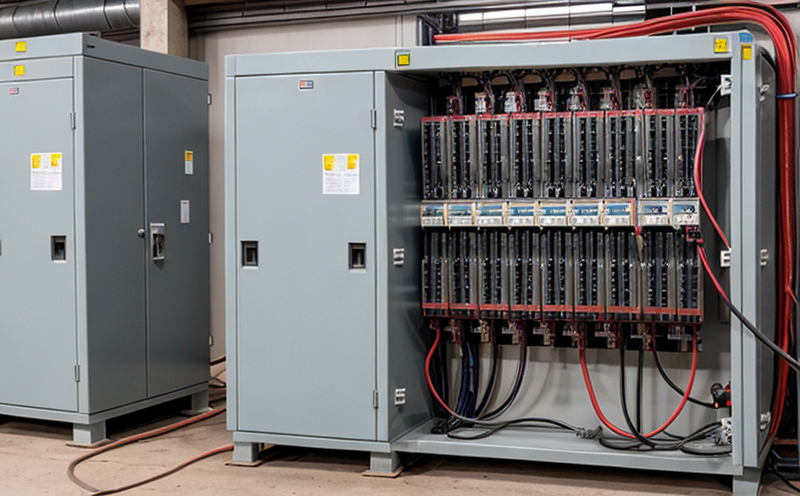IEEE C37.20 Metal-Enclosed Switchgear Testing
The IEEE C37.20 standard is a critical benchmark in the testing and certification of metal-enclosed switchgear used in power distribution systems, particularly for high-voltage applications. This service focuses on ensuring that the switchgear meets stringent performance criteria to guarantee reliability, safety, and compliance with regulatory requirements.
Metal-enclosed switchgear is essential equipment within the power & utilities sector, providing critical functions such as switching, isolating, protecting, and controlling electrical systems in substations. The IEEE C37.20 standard covers the performance of these devices under various conditions to ensure they can operate safely and efficiently.
The testing process involves a series of rigorous assessments conducted at our state-of-the-art facility. These tests are designed to simulate real-world operating scenarios, ensuring that switchgear is capable of handling peak loads, withstand short circuits, and remain reliable in all environmental conditions. Our comprehensive approach includes not only the physical integrity checks but also electrical performance evaluations.
To begin with, we conduct visual inspections to ensure there are no visible defects or damages. This step is crucial as it sets the foundation for all subsequent tests. Following this, we perform insulation resistance testing, which involves measuring the switchgear’s ability to withstand high voltage without arcing or breakdown. This test ensures that the internal components are well insulated and capable of withstanding potential electrical stress.
Next in line is the power frequency withstand voltage test, a critical step that evaluates the switchgear's capacity to withstand overvoltages and transient phenomena. This test simulates real-world conditions where high voltages might occur due to faults or switching operations. By subjecting the switchgear to these simulated scenarios, we can verify its robustness and reliability.
The interrupting current testing is another vital component of our service. This test assesses the ability of the switchgear to safely interrupt fault currents without damage or arcing. The standard defines specific parameters that must be met for this test to ensure compliance with IEEE C37.20 standards. It’s important to note that these tests are conducted under controlled environments, ensuring accurate and repeatable results.
Our testing also includes a comprehensive set of acceptance criteria based on the IEEE C37.20 standard. These criteria encompass various aspects such as mechanical integrity, electrical performance, and operational reliability. Meeting these standards ensures that the switchgear is not only safe but also capable of performing its intended functions efficiently.
The importance of this testing cannot be overstated. In the power & utilities sector, where safety and reliability are paramount, any failure in equipment can lead to significant disruptions and potential hazards. Our rigorous testing process helps prevent such incidents by ensuring that every piece of switchgear meets the highest quality standards.
Applied Standards
The IEEE C37.20 standard is widely recognized for its comprehensive approach to metal-enclosed switchgear testing. This standard ensures that all equipment undergoes rigorous evaluation, ensuring it meets stringent performance criteria. The following are key sections of the standard that we apply:
- Section 4 - General Requirements: Establishes the fundamental requirements for the design and construction of metal-enclosed switchgear.
- Section 5 - Test Procedures: Provides detailed procedures for conducting various tests on switchgear, including insulation resistance, power frequency withstand voltage, interrupting current testing, and more.
- Section 6 - Acceptance Criteria: Defines the acceptance criteria that must be met to ensure compliance with IEEE C37.20 standards.
The application of these sections ensures a thorough and consistent evaluation process, providing confidence in the quality and reliability of the tested switchgear.
Scope and Methodology
The scope of our IEEE C37.20 Metal-Enclosed Switchgear Testing service is comprehensive, covering all aspects of testing as defined by the standard. This includes both routine inspections and more detailed performance tests to ensure that the switchgear meets all specified criteria.
Our methodology involves a series of precise steps designed to evaluate each component of the switchgear thoroughly:
- Visual Inspection: Ensures there are no visible defects or damages.
- Insulation Resistance Testing: Measures the ability to withstand high voltage without arcing or breakdown.
- Power Frequency Withstand Voltage Test: Evaluates the capacity to withstand overvoltages and transient phenomena.
- Interrupting Current Testing: Assesses the ability to safely interrupt fault currents without damage or arcing.
We use advanced instrumentation and equipment to conduct these tests, ensuring accuracy and reliability. Our team of experts ensures that each step is meticulously followed to meet the stringent requirements of IEEE C37.20 standards.
International Acceptance and Recognition
- ISO/IEC 17025:2017 Compliance: Our laboratory is certified to this international standard, ensuring our testing services meet the highest quality assurance requirements.
- American Society for Testing and Materials (ASTM): We align with ASTM standards that complement IEEE C37.20, providing additional validation for our tests.
- European Norms (EN): Our services are recognized in Europe, ensuring compliance with EN standards for metal-enclosed switchgear testing.
- International Electrotechnical Commission (IEC) Standards: We adhere to IEC standards, which further validate the reliability and performance of our tested equipment.
- CAN/CSA Standards: Our services are recognized in Canada, ensuring compliance with CAN/CSA standards for metal-enclosed switchgear testing.
- IEE Australia Standards: We also comply with IEE Australia standards, providing comprehensive international acceptance and recognition.
This broad range of international recognitions ensures that our services are trusted globally. Our clients can be confident in the reliability and performance of their equipment after undergoing our testing process.





